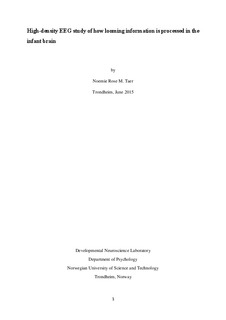High-density EEG study of how looming information is processed in the infant brain
Master thesis
Permanent lenke
http://hdl.handle.net/11250/2437069Utgivelsesdato
2015Metadata
Vis full innførselSamlinger
Sammendrag
Looming images indicate the rapid approach of objects and provide warning information about the impending impact. Prospective control when responding to a looming virtual object approaching on a direct collision course was studied longitudinally in 12 infants aged 3/4 and 11/12 months. Brain electrical recordings (EEG) and different characteristics of the looming-related visual evoked potential (VEP) were explored and compared between the infants at these different ages. The aim of this study was to investigate how infants at this early age process looming stimuli approaching on a direct collision course under three different accelerations. It was also investigated how neural information is processed in the infant brain by applying the General Tau Theory. The results showed that the timing and the duration of the VEP responses differed with age. At the age of 3/4 months, infants showed VEP peaks after the looming virtual objects had hit them. At the age of 11/12 months, on the other hand, infants showed clear looming-related VEP peaks before virtual impact. Further, the application of the General Tau Theory showed that when looming-related information flows inside the neurons in a particular brain region, infants’ ability to pick up the flow improves as they mature and get more locomotor experience providing them more veridical information about time-to-collision information. Brain maturation together with a dramatic increase in locomotor experience during the first year of life in infancy could explain the developmental trend in our study. Further studies is needed to investigate brain associated activity with infants’ perception of looming motion.
